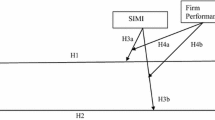Abstract
The effect of recruiter behaviors on organizational attractiveness is the focus of a growing body of literature. The elaboration likelihood model (ELM) is a promising model for generating research examining how and when recruiter behaviors will influence job applicant attitudes formed during the recruitment process. In this paper, the ELM is described and considered in relation to variables that affect job applicant ability and motivation to accurately process information about organizational and job attributes and assess their fit with a firm during the recruitment process. In addition, several recruiter behaviors and characteristics known to affect applicant attraction to the firm are discussed in terms of the ELM.
Similar content being viewed by others
REFERENCES
Barron, J., & Gilley, D.W. (1979). The effect of unemployment insurance on the search process. Industrial and Labor Relations Review, 32, 363–366.
Behling, O., Labovitz, G., & Geiner, M. (1968). College recruiting: A theoretical base. Personnel Journal, 47, 13–19.
Brockner, J. (1988). Self-esteem at work. Lexington, MA: Lexington Books.
Bureau of National Affairs. (1989). Now hiring: An employer's guide to recruiting in a tight labor market. Washington, DC: Author.
Burgess, P., & Kingston, J. (1981). UI benefit effects on compensated unemployment. Industrial Relations, 20, 258–270.
Byrne, D. (1971). The attraction paradigm. New York: Academic Press.
Cable, D., & Judge, T.A. (1996). Person-organization fit, job choice decisions, and organizational entry. Organizational Behavior and Human Decision Processes, 67, 294–311.
Chatman, J.A. (1991). Matching people and organizations: Selection and socialization in public accounting firms. Administrative Science Quarterly, 36, 459–484.
Cohen, J. (1980). Aftereffects of stress on human performance and social behavior: A review of research and theory. Psychological Bulletin, 37, 583–615.
Coleman, D.F., & Irving, P.G. (1997). The influence of source credibility attributions on expectancy theory predictions of organizational choice. Canadian Journal of Behavioural Science, 29, 122–131.
DeBell, C.S., Montgomery, M.J., McCarthy, P.R., & Lantheir, R.P. (1998). The critical contact: A study of recruiter verbal behavior during campus interviews. The Journal of Business Communication, 35, 202–224.
Dipboye, R.L. (1992). Selection interviews: Process perspectives. Cincinnati, OH: South-Western.
Ellis, R.A., & Taylor, M.S. (1983). role of self-esteem within the job search process. Journal of Applied Psychology, 68, 632–640.
Fisher, C., Ilgen, D.W., & Hoyer, W. (1979) Source credibility, information favorability, and job offer acceptance. Academy of Management Journal, 22, 94–103.
Goltz, S.M., & Giannantonio, C.M. (1995). Recruiter friendliness and attraction to the job: The mediating role of inferences about the organization. Journal of Vocational Behavior, 46, 109–118.
Harris, M.M. (1989). Reconsidering the employment interview: A review of recent literature and suggestions for future research. Personnel Psychology, 42, 691–727.
Harris, M.M., & Fink, LS. (1987). A field study of applicant reactions to employment opportunities: Does the recruiter make a difference? Personnel Psychology, 42, 691–726.
Luck, R. (1988, September 26). How industrial recruiters sell themselves short. Wall Street Journal, p. 26.
Petty, R., & Cacioppo, J. (1986). The elaboration likelihood model of persuasion. In L. Berkowitz (Ed.), Advances in experimental social psychology, pp. 123–205. Orlando, FL: Academic Press.
Powell, G.N. (1984). Effect of job attributes and recruiting practices on applicant decisions: A comparison. Personnel Psychology, 37, 721–732.
Powell, G.N. (1991). Applicant reaction to the initial employment interview: Exploring theoretical and methodological issues. Personnel Psychology, 44, 67–83.
Ralston, S.M., & Brady, R. (1994). The relative influence of interview communication satisfaction on applicants' recruitment interview decisions. The Journal of Business Communication, 31, 61–77.
Rand, T.M., & Wexley, K.N. (1975). Demonstration of the effects, "similar to me," in simulated employment interviews. Psychological Reports, 36, 535–544.
Rynes, S.L. (1991). Recruitment, job choice, and post-hire consequences: A call for new research directions. In M.D. Dunnette & L.M. Hough (Eds.), Handbook of industrial and organizational psychology (2nd ed., Vol. 2, pp. 399–444). Palo Alto: Consulting Psychologists Press.
Rynes, S.L., & Barber, A.E., (1990). Applicant attraction strategies: An organizational perspective. Academy of Management Review, 15, 286–310.
Rynes, S.L., Bretz, R.D., & Gerhart, B. (1991). The importance of recruitment in job choice: A different way of looking. Personnel Psychology, 44, 487–521.
Rynes, S.L., Heneman, H.G., & Schwab, D.P. (1980). Individual reactions to organizational recruiting: A review. Personnel Psychology, 33, 529–542.
Rynes, S.L., & Miller, H.E. (1983). Recruiter and job influences on candidates for employment. Journal of Applied Psychology, 68, 147–154.
Saks, A.M. (1989). An examination of the combined effects of realistic job previews, job attractiveness and recruiter affect on job acceptance decisions. Applied Psychology: An International Review, 38, 145–163.
Schmitt, N., & Coyle, B. (1976). Applicant decisions in employment interview. Journal of Applied Psychology, 61, 184–192.
Schwab, D.P., Rynes, S.L., & Aldag, R.J. (1987). Theories and research on job search and choice. In G.R. Ferris & K.M. Rowland (Eds.), Research in Personnel and Human Resource Management, Vol. 5, pp. 129–166. Greenwich, CT: JAI Press.
Sheppard, H.L., & Belitsky, A.H. (1966). The job hunt. Baltimore: John Hopkins Press.
Taylor, M.S., & Bergmann, T.J. (1987). Organizational recruitment activities and applicants' reactions at different stages of the recruitment process. Personnel Psychology, 40, 261–285.
Thomas, K.M, & Wise, P.G. (1999). Organizational attractiveness and individual differences: Are diverse applicants attracted by different factors? Journal of Business and Psychology, 13, 375–390.
Turban, D.B., & Dougherty, T.W. (1992). Influences of campus recruiting on applicant attraction to firms. Academy of Management Journal, 35, 739–765.
Turban, D.B., Forret, M.L., & Hendrickson, C.L. (1998). Applicant attraction to firms: Influences of organization reputation, job and organizational attributes, and recruiter behaviors. Journal of Vocational Behavior, 52, 24–44.
Wanous, J.P., & Colella, A. (1989). Organizational entry research: current status and future directions. In G.R. Ferris & K.M. Rowland (Eds.), Research in Personnel and Human Resource Management, Vol. 7, pp. 59–120. Greenwich, CT: JAI Press.
Author information
Authors and Affiliations
Rights and permissions
About this article
Cite this article
Larsen, D.A., Phillips, J.I. Effect of Recruiter on Attraction to the Firm: Implications of the Elaboration Likelihood Model. Journal of Business and Psychology 16, 347–364 (2002). https://doi.org/10.1023/A:1012816822546
Issue Date:
DOI: https://doi.org/10.1023/A:1012816822546




